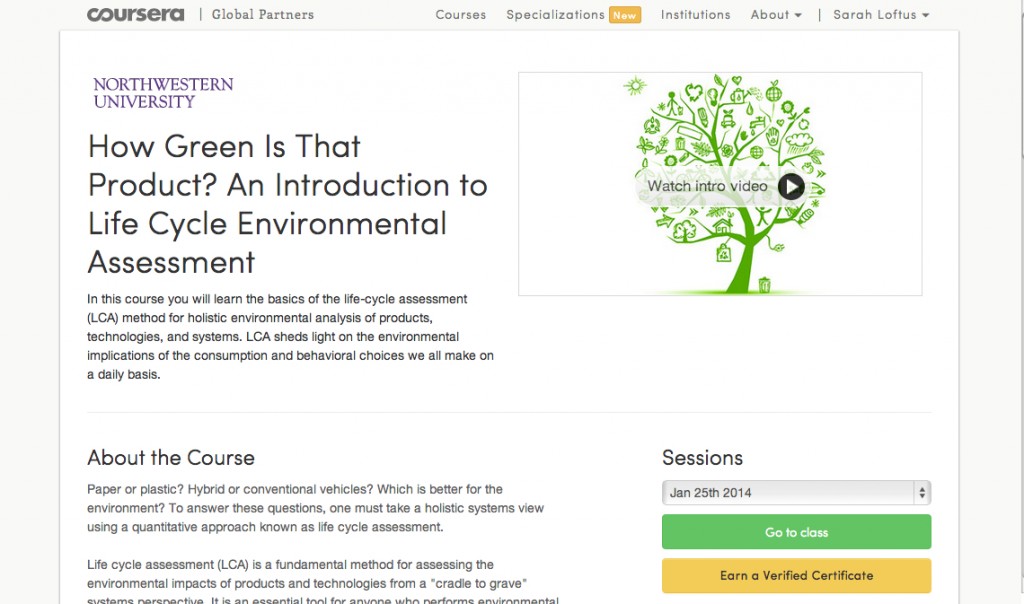This year I jumped onto the MOOC bandwagon, which has swiftly accelerated in the past few years. Massive open online courses, called MOOCs, gained a rapid growth in student participation after three major MOOCs kicked off in 2012, including Coursera, edX, and Udacity. Each is now used by millions of students from around the world.
My MOOC Experience
My own journey into the land of MOOCs began with a sigh-inducing “There is a conflict in your schedule” message that popped up online while planning my spring courses. Two courses, Molecular Ecology and Environmental Life Cycle Assessment (LCA), met at the same time and I had to choose just one. Or did I? Having a housemate who is a Coursera user for both research-related courses and courses for fun, I’d learned of its benefits and decided to browse the website. The breadth and appeal of the courses, not to mention the dozens of well-known universities that offered them, amazed me.
Fortunately, Northwestern University was offering an Environmental LCA course that started in January. LCA is a method that analyzes all the inputs that go into producing a certain product or service to determine its feasibility and environmental impacts. I want to learn more about this method because many researchers perform LCAs for the production of algal biofuels. The course started this week, and by April we’ll have completed our own LCA models of a certain product using the tools taught in lecture videos and notes.
While I browsed this LCA course back in December, Coursera produced a list of related courses. I couldn’t resist clicking on them, and after much thought I decided to go ahead and enroll in another one. I thoroughly compared the handful of the courses that focused on Energy Production, and chose one that I thought was the best fit. 80,000 other students and I are currently in Week 4 of this energy course, which provides an overview of different energy sources, their impacts, and how they are produced or obtained. Discussion forums in the course have introduced me to people in the energy sector and in environmental fields. Courses are free and students earn a Statement of Accomplishment for completing the lessons, quizzes, and assignments, but a Verified Certificate costs about $50.
MOOCs’ great successes not reflected in completion rates
Last month, NPR’s All Things Considered reviewed the “fall of MOOCs,” comparing the courses’ considerably low completion rates to their predicted success by the New York Times. It’s true that MOOCs cannot fully replace an educational experience with student-professor interactions nor can they achieve the same completion rates. But when MOOCs are considered as a supplement instead of a substitute, their successes are extremely monumental.
For example, some people take a course because they are interested in a few specific lessons and not the rest. Even if they do not complete the course, the MOOC still met their learning goals with those few lessons. MOOCs allow the learning process to continue at any life stage, and provide organized structure and reputable sources for those who find hours of Googling unappealing. And even with a seemingly measly completion rate of 5%, for a course with 80,000 students that’s still 4000 passing students, more than could fit in any lecture hall on most college campuses.
MOOCs and College
My courses and responsibilities at Duke take priority over Coursera, but the Coursera courses are providing information and tools that are relevant to the issues and systems I am interested in. They are supplements, ones that I am able to take advantage of in my first year of graduate school, which is focused on taking courses before I move to the Marine Lab at the end of the semester. Interactions with TAs, professors, and other students at office hours and labs were a vital and frequent component of my undergraduate education that simply cannot be replicated by MOOCs, but for MOOCs that’s not really the point. The point is that anyone with access to a computer and internet can learn new concepts and tools for free, with lessons organized by respected educators.
Some college courses are now using MOOCs in what are known as “flipped classrooms,” in which students view lectures online and then complete assignments during class time in the presence of professors and TAs. For example, one of the 19 courses offered by Duke on Coursera is Mohamed Noor’s “Introduction to Genetics and Evolution.” Duke students enroll in the Coursera course, and on campus they take lab sections and work on practice problems during class periods. You can read more about out how this flipped classroom operated in Noor’s blog post.
For anyone who wants to satiate their own learning interest, or for a student who wants an uninterrupted day of work in the lab but also the chance to learn new things broadly relevant to their research, taking a MOOC while eating breakfast at the kitchen table may be a convenient and appealing option. Stephen Thrun, the founder of Udacity, believes in a “lifelong education,” and MOOCs are an excellent opportunity for that.



Hi Sarah,
Good to read this post.
I had actually heard of khan academy, not interests like coursera. I’m very glad to hear about it. While browsing course list on coursera yesterday, I found few interesting and relevant courses. I thought about it a while, and decided to enroll in two courses. So far the courses seem going very well.
Besides having many advantages, like the ones you mentioned, I think MOOCs might be especially exciting and helpful for those who don’t have enough money to pay for courses.
Besides, students can prepare their own schedules to complete the course they are interested in.
With MOOCs, the foreseeable future looks good for interested students!!
Good Day!